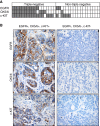Triple-negative breast cancer is associated with EGFR, CK5/6 and c-KIT expression in Malaysian women
- PMID: 23009686
- PMCID: PMC3582471
- DOI: 10.1186/1472-6890-12-18
Triple-negative breast cancer is associated with EGFR, CK5/6 and c-KIT expression in Malaysian women
Abstract
Background: Triple-negative breast cancer (TNBC) is a heterogeneous subgroup of breast cancer characterized by the lack of estrogen receptor (ER), progesterone receptor (PR) and the human epidermal growth factor receptor 2 (HER2) expressions. This subgroup of refractory disease tends to have aggressive clinical behavior, high frequency of metastasis and lack of response to current hormonal or targeted therapies. Despite numerous studies reporting the clinicopathological features of TNBC and its association with the basal-like phenotype in the Western population, only limited data are available in the Asian population. Therefore, the aim of this study was to investigate the clinicopathological characteristics of TNBC and its association with epidermal growth factor receptor (EGFR), cytokeratin 5/6 (CK5/6) and mast/stem cell growth factor receptor (c-KIT or CD117) expression in Malaysian women.
Methods: A total of 340 patients diagnosed with primary breast cancer between 2002 and 2006 in Malaysia were reviewed and analyzed.
Results: The incidence of TNBC was 12.4% (42/340). Bivariate analysis revealed that TNBC was strongly associated with a younger age, higher grade tumor and p53 expression. Further immunohistochemical analysis suggested that TNBC in Malaysian women was strongly associated with EGFR, CK5/6 and c-KIT expression with high a Ki-67 proliferation index.
Conclusion: In conclusion, our study confirms the association of TNBC with basal-like marker expression (EGFR, CK5/6 and c-KIT) in Malaysian women, consistent with studies in other populations.
Figures


Similar articles
-
Immunohistochemical co-expression status of cytokeratin 5/6, androgen receptor, and p53 as prognostic factors of adjuvant chemotherapy for triple negative breast cancer.Med Mol Morphol. 2016 Mar;49(1):11-21. doi: 10.1007/s00795-015-0109-0. Epub 2015 May 26. Med Mol Morphol. 2016. PMID: 26009308
-
Stratification of Prognosis of Triple-Negative Breast Cancer Patients Using Combinatorial Biomarkers.PLoS One. 2016 Mar 1;11(3):e0149661. doi: 10.1371/journal.pone.0149661. eCollection 2016. PLoS One. 2016. PMID: 26930401 Free PMC article.
-
Lack of Androgen Receptor Expression Selects for Basal-Like Phenotype and Is a Predictor of Poor Clinical Outcome in Non-Metastatic Triple Negative Breast Cancer.Front Oncol. 2020 Jul 28;10:1083. doi: 10.3389/fonc.2020.01083. eCollection 2020. Front Oncol. 2020. PMID: 32850312 Free PMC article.
-
Potential prognostic tumor biomarkers in triple-negative breast carcinoma.Beijing Da Xue Xue Bao Yi Xue Ban. 2012 Oct 18;44(5):666-72. Beijing Da Xue Xue Bao Yi Xue Ban. 2012. PMID: 23073572 Review.
-
Triple-negative breast cancer: current state of the art.Tumori. 2010 Nov-Dec;96(6):875-88. Tumori. 2010. PMID: 21388048 Review.
Cited by
-
Fibroblast growth factor receptor 4 (FGFR4) and fibroblast growth factor 19 (FGF19) autocrine enhance breast cancer cells survival.Oncotarget. 2016 Sep 6;7(36):57633-57650. doi: 10.18632/oncotarget.9328. Oncotarget. 2016. PMID: 27192118 Free PMC article.
-
Relative influence of c-Kit expression and epidermal growth factor receptor gene amplification on survival in patients with non-small cell lung cancer.Oncol Lett. 2014 Aug;8(2):582-588. doi: 10.3892/ol.2014.2173. Epub 2014 May 23. Oncol Lett. 2014. PMID: 25013472 Free PMC article.
-
Metabolic role of fatty acid binding protein 7 in mediating triple-negative breast cancer cell death via PPAR-α signaling.J Lipid Res. 2019 Nov;60(11):1807-1817. doi: 10.1194/jlr.M092379. Epub 2019 Sep 4. J Lipid Res. 2019. PMID: 31484694 Free PMC article.
-
c-Kit Induces Migration of Triple-Negative Breast Cancer Cells and Is a Promising Target for Tyrosine Kinase Inhibitor Treatment.Int J Mol Sci. 2022 Aug 5;23(15):8702. doi: 10.3390/ijms23158702. Int J Mol Sci. 2022. PMID: 35955836 Free PMC article.
-
Androgen receptor, EGFR, and BRCA1 as biomarkers in triple-negative breast cancer: a meta-analysis.Biomed Res Int. 2015;2015:357485. doi: 10.1155/2015/357485. Epub 2015 Jan 28. Biomed Res Int. 2015. PMID: 25695063 Free PMC article. Review.
References
-
- Sorlie T, Perou CM, Tibshirani R, Aas T, Geisler S, Johnsen H, Hastie T, Eisen MB, van de Rijn M, Jeffrey SS. et al.Gene expression patterns of breast carcinomas distinguish tumor subclasses with clinical implications. Proc Natl Acad Sci U S A. 2001;98(19):10869–10874. doi: 10.1073/pnas.191367098. - DOI - PMC - PubMed
LinkOut - more resources
Full Text Sources
Other Literature Sources
Research Materials
Miscellaneous

